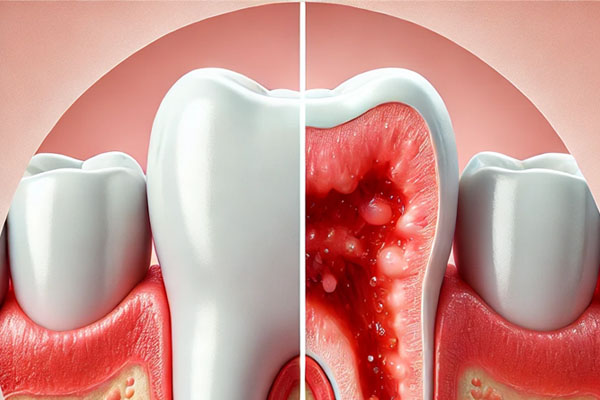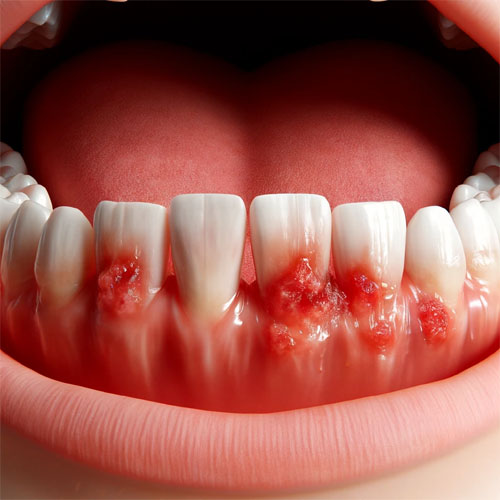Periodontitis, commonly known as gum disease, is more than just a dental issue—it’s a condition that can significantly impact your overall health. The good news? Early detection can prevent severe complications and keep your smile intact. By understanding how dentists diagnose periodontitis, you’ll be better equipped to take charge of your oral health and avoid the pain and expense that come with advanced gum disease.

What is Periodontitis and Why Should You Care?
Periodontitis is an infection of the gums that can destroy the tissues and bones that support your teeth. What starts as mild inflammation (gingivitis) can progress into a serious problem if left untreated. Once periodontitis sets in, it can lead to tooth loss, and studies have shown links between gum disease and conditions like heart disease, diabetes, and stroke.
Why Taking Action Matters
The earlier you detect periodontitis, the easier it is to treat. If you’re experiencing any of the following symptoms, it’s time to act:
- Red, swollen, or tender gums
- Bleeding when brushing or flossing
- Chronic bad breath
- Gums receding or pulling away from teeth
- Loose or shifting teeth
These signs indicate ill health in your body and its needs attention. Ignoring them could mean much bigger problems down the road.
The First Step: A Thorough Examination by Your Dentist
The journey to healthy gums starts with a comprehensive dental exam. When you visit your dentist, they won’t just look at your teeth—they’ll carefully examine your gums for signs of inflammation, recession, and bleeding. But the visual exam is only the beginning. Dentists have a variety of tools to detect periodontitis early, and catching it at this stage can save you from more aggressive treatments later.
Medical History: It’s Not Just About Your Teeth
Did you know that your medical history plays a key role in your gum health? Conditions like diabetes and lifestyle factors like smoking can dramatically increase your risk of gum disease. By reviewing your medical history, your dentist can tailor a treatment plan specifically for you. This personalized approach ensures you’re not only addressing the symptoms but also tackling the underlying causes.
Probing Depth: Measuring the Health of Your Gums
One of the most reliable ways dentists diagnose periodontitis is by measuring the depth of the pockets between your teeth and gums. They use a special tool called a periodontal probe, and this simple procedure can reveal a lot about the health of your gums.
How Deep Should Your Gum Pockets Be?
In a healthy mouth, gum pockets should measure between 1 and 3 millimeters. When periodontitis sets in, these pockets deepen as the gums pull away from the teeth, creating space for bacteria to thrive. If your dentist finds pockets measuring 4 millimeters or more, it’s time to take action before the condition worsens.
X-Rays: A Clear View of the Damage Below the Surface
Probing depth tells dentists a lot about the health of your gums, but X-rays give them a clear view of the bone structure supporting your teeth. Periodontitis doesn’t just affect the gums—it destroys the bone, too. If left unchecked, this bone loss can lead to loose teeth, or worse, tooth loss.
Why You Shouldn’t Wait Until You Feel Pain
One of the most dangerous aspects of periodontitis is that it doesn’t always hurt in the early stages. By the time you’re in pain, significant damage could have already occurred. X-rays allow your dentist to detect bone loss early, giving you a head start on treatment before the disease progresses.
Bacterial Testing: Targeting the Root Cause
In some cases, your dentist may recommend a bacterial analysis to identify the specific types of bacteria causing the infection. This extra step can help pinpoint the exact strain of bacteria responsible for your gum disease, allowing for a more targeted treatment plan that effectively stops the progression of periodontitis.
Why Bacteria Testing Makes a Difference
Identifying the specific bacteria involved can be the difference between a standard treatment and a highly personalized one. With bacterial testing, your dentist can choose the most effective antibiotics or treatments that directly address the root cause of your periodontitis.

Diagnosing Advanced Periodontitis: Don’t Let It Get to This Stage
While early detection is key, some patients don’t visit the dentist until the disease has advanced. Dentists diagnose advanced periodontitis by looking for more severe signs, including:
- Deep gum pockets (6 millimeters or more)
- Significant gum recession
- Loose or shifting teeth
- Visible bone loss on X-rays
At this stage, the disease requires more aggressive treatment, such as surgery, to restore the gums and prevent further damage.
The Cost of Waiting
By the time periodontitis has advanced, you’re not just looking at gum health issues—you could be facing tooth loss, jawbone damage, and costly, invasive treatments. Regular dental checkups can help you avoid this, saving you from painful procedures and heavy expenses.
Treatment Planning: What Happens After Diagnosis?
Once your dentist has diagnosed periodontitis, they’ll create a personalized treatment plan based on the severity of the disease. Treatment might include:
- Scaling and root planing: A deep cleaning procedure to remove plaque and tartar from beneath the gumline.
- Antibiotic therapy: To eliminate harmful bacteria and control infection.
- Surgical procedures: In severe cases, gum grafts or bone grafts may be necessary to restore damaged tissue.
Early treatment is far less invasive, making regular checkups and prompt action essential for maintaining your gum health.
Take Control of Your Oral Health: Prevention is the Best Cure
Many people wait until they experience pain to visit the dentist, but that’s the worst thing you can do when it comes to periodontitis. Gum disease is often silent, progressing without noticeable symptoms until it’s too late. By seeing your dentist regularly—at least every six months—you give yourself the best chance to detect gum disease early, when it’s easiest to treat.
Why You Can’t Afford to Wait
Gum disease doesn’t just affect your mouth. Research shows that it’s linked to a range of systemic health issues, including heart disease and diabetes. Don’t wait for symptoms to appear—get ahead of the problem. Regular dental visits allow your dentist to catch issues early and keep you in optimal health.
Conclusion: Protect Your Smile by Acting Now
Diagnosing periodontitis requires a combination of careful exams, probing depth measurements, X-rays, and sometimes bacterial testing. But the real secret to beating gum disease is early detection and prevention. Don’t wait until you’re in pain—take charge of your oral health today. By visiting your dentist regularly and paying attention to the signs of gum disease, you can preserve your smile and avoid the complications that come with advanced periodontitis.
Your oral health is in your hands, and it’s never too late to start protecting it. Make an appointment with your dentist today and ensure your smile lasts a lifetime.

